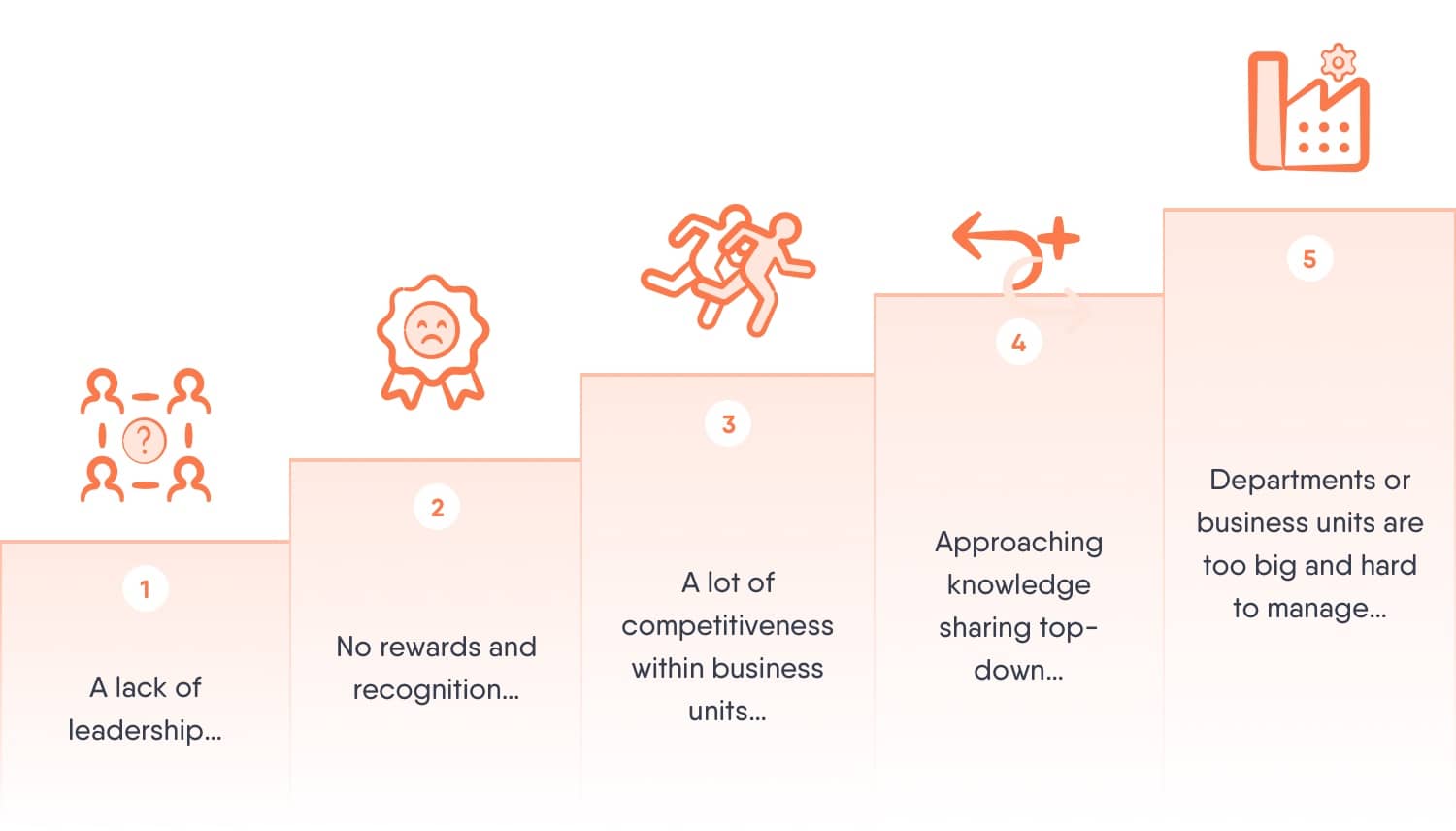Kasper Spiro is the Co-founder and Chief learning strategist of Easygenerator and a recognized thought leader in the world of e-learning. With over 30 years of experience, he is a frequently requested keynote speaker and well-renowned blogger within the e-learning community.
Knowledge sharing: The ultimate guide
From what knowledge sharing is to its barriers, benefits and much more.

Introduction
Employees are your organization’s greatest assets. They are sources of information and expertise. Let them share knowledge effectively, and everyone within the organization will benefit.
In this comprehensive guide, we’ll take you through the ins and outs of workplace knowledge management and advise you on the best knowledge sharing software and platforms so you can overcome the barriers to knowledge sharing in your organization and start reaping the benefits today.
What is knowledge sharing?
How many employees work at your organization? And how many of those would you say are experts in what they do? All of them, right? Imagine how much knowledge moves through all those teams and departments every day.
Imagine what would happen if you could all really know what your organization knows. There is a way to let your employees tap into each other’s expertise and apply it to develop themselves and perform better. It’s called knowledge sharing.
By definition, knowledge sharing is the exchange of information, expertise, or skills. With the proper tools and management, employees can effectively apply knowledge sharing and leverage each other’s expertise. Sharing can be done in many ways.
By giving each other presentations, organizing workshops, video calling, e-mailing each other relevant files, on intranet, with e-learning, and more. Do you want to know what knowledge sharing could look like in your organization? Use this article as your guide and let it inspire you.
Why knowledge sharing is important
Employees have a lot of expertise that is vital for the organization at which they work. And for their co-workers. By sharing their knowledge with colleagues, employees can connect, deepen their knowledge, and help each other perform better.
Supporting each other and being seen an expert is good for employees’ sense of satisfaction and belonging. It makes them stronger as professionals. Of course, knowledge sharing also has benefits for your organization.
Benefits of knowledge sharing
There are various benefits of sharing knowledge at work. For one, having employees exchange everything they know with each other allows them to work efficiently. And when your employees have access to everything their colleagues know, there is a great deal of knowledge your entire organization can draw from and profit of. It won’t be necessary to invest in training from external parties or off-the-shelf courses as much anymore.
The resources employees use instead are made by themselves, and therefor easy to maintain. Another benefit is that your employees have control over these resources, and so knowledge shared will never be out of date. With this way of working, employees can learn as fast as your organization develops. Discover how to turn curation into knowledge sharing.
Employee-generated Learning: a knowledge sharing approach
There are many knowledge sharing models and approaches organizations can apply. A few examples are Communities of Practice, Social Learning, Collaborative learning and more. These examples are instrumental in actualizing the principles of knowledge sharing. However, our home-grown approach of Employee-generated Learning is a very beneficial route to quickly enable knowledge sharing within an organization.
This is a learning and development methodology that shifts the responsibility for creating content from instructional designers to employees, because it lets them capture their knowledge and share it with their peers. Ideally, employees have access to a simple authoring tool for the creation of content. Why is this so valuable? It gives other employees access to effective, relevant material that is based on the best practices of their colleagues.
Employee-generated Learning also engages people and gives them recognition and clout within the organization. Because knowledge is captured and shared in-house, this approach will help you to reduce costs; maintain shared content easily; and easily and quickly distribute knowledge among hundreds of employees, no matter where they are located.
Make knowledge sharing interactive and cloud-based with e-learning
Employees share knowledge in different ways. Over a coffee or during lunch, with meetings and by sharing files or giving presentations. That means that employees learn in different ways, too. In fact, learning occurs through a mix of formal, informal and experiential learning. This is called the 70:20:10 methodology: employees learn 70% of their knowledge on the job, 20% by sharing knowledge, and 10% by formal training.
Simple e-learning authoring tools are ideal for Employee-generated Learning. And thus for knowledge sharing. These tools let employees create content based on their expertise, quickly and efficiently.
The content they create can have many different shapes and forms, like training, checklists, guides, and so on. Interactive content can be created, like quizzes or bite-sized nuggets of microlearning content.
Some tools even allow colleagues to give each other and instant feedback. Thanks to the nature and endless possibilities of these authoring solutions, they cover the entire 70:20:10 model. And so, authoring solutions are the ultimate form of Employee-generated Learning and knowledge sharing.
Best knowledge sharing platforms
Are you looking for the right tool, system, or platform to use for to let employees in your organization share knowledge? There are many different employee knowledge sharing tools, systems, and platforms, which can make it challenging to make the right decision. In the complex world of knowledge sharing tools, our advice is to get past what we call the PowerPoint mindset. So, converting powerpoint to elearning

The best knowledge sharing platforms let employees capture knowledge and create content in a fun and engaging way, without feeling the burden of “having to design content”. We have done research among subject matter experts and found that we can distinguish two main types of content tools.
- Closed knowledge sharing tools and systems. For example, wiki-style documents, information systems, and tools such as Rise. These are great for creating and sharing files with information. However, they lack structure and features for employees who want to create interactive content. Also, created content can only be accessed within these tools, making it hard for employees to share it.
- Open knowledge sharing systems, such as an intranet, Google Drive, SharePoint, or our own tool. Open systems allow for created content to be shared outside of the system itself, for example via e-mail or Slack. These tools are the best solution for knowledge sharing, because employees can access content anytime, anywhere, without having to be a part of the system.
The benefits of a zero-learning employee knowledge sharing tool
An ideal tool for this purpose is a zero-learning authoring tool that employees can use without training or experience. Such solutions function as a mere medium that has no bells and whistles and can be used easily by employees who don’t have a didactic background.
Some authoring solutions let colleagues pair up and create content together, track each other’s progress, and publish and share courses flexibly so they can truly experience the beauty of knowledge sharing.
Knowledge sharing in knowledge management
Have you ever felt like you miss a structured and effective environment in which employees can optimally capture and share knowledge? You’re not alone. Knowledge management is a challenge in many companies. In order to embrace knowledge sharing, the right technological tools are needed to facilitate it.
And that’s when knowledge management becomes essential, because it enables companies to capture, organize, and leverage that knowledge to the highest possible benefit. How? By streamlining the entire process. Equip employees with two main things:
- Tools to capture, share, or store their knowledge
- Didactic guidance to do it in the proper way
The benefits of knowledge management
A knowledge management process can enhance efficiency and create space for innovative thinking and the sharing of knowledge among employees. When done successfully, this can push their performance to higher levels. But knowledge management offers more benefits:
- Your organization can save money when you enable employees to share knowledge through a knowledge management system
- With the right management, knowledge sharing is practical, on-demand, and allows employees to apply information immediately, so it improves performance
By capturing the relevant knowledge and making it available, you can serve the entire organization’s needs. Even if employees are located in different cities, area’s or countries.
Knowledge sharing barriers
 Do you want your organization to start leveraging on employees’ knowledge by enabling them to effectively share it with their peers? It might take time for some of your colleagues to get into the new mindset. That’s completely normal. You can inform them about Employee-generated Learning in connection to knowledge sharing, and lay out the benefits:
Do you want your organization to start leveraging on employees’ knowledge by enabling them to effectively share it with their peers? It might take time for some of your colleagues to get into the new mindset. That’s completely normal. You can inform them about Employee-generated Learning in connection to knowledge sharing, and lay out the benefits:
- It’s a way to spend less money, because resources are made based on knowledge that’s in-house
- When using a simple authoring tool, it’s easy to maintain content. Employees can update resources whenever it’s needed
- All your organization’s employees have access to content, if you use an open system to share it in. That means hundreds of employees can access and apply knowledges shared by their colleagues, no matter where they are located
Still, you might have to jump some hurdles in order to get this approach going. Prepare yourself well by understanding people might worry about.
Personal knowledge sharing barriers and how to overcome them
Some employees might have some personal barriers, like:
- The lack of time to share knowledge and identify colleagues in need of specific information.
- Not realizing that employees have knowledge that is valuable for others.
- The fear that sharing knowledge may jeopardize one’s job security.
To overcome these, it’s important to encourage employees to develop knowledge sharing as a core competency. Here are some ideas on how to do so:
- Chances are high knowledge sharing and Employee-generated Learning will save time. Employees don’t have to answer colleagues’ questions anymore, they can just share content they have created with them.
- The value lies in the fact that knowledge is unlocked, and everybody can access and apply it. Employees will be acknowledged as experts, and practicing knowledge sharing will show them the value of their expertise.
- If employees fear that knowledge sharing may jeopardize their job security, let them know that sharing will be rewarded
Organizational knowledge sharing barriers and how to overcome them
You might encounter hurdles when you try to convince the organization about the implementation of knowledge sharing. Knowledge sharing holds the solution itself. Point out the benefits and share articles that focus on the advantages of knowledge sharing. Obstacles you might experience with are:
- A lack of leadership, knowledge management strategy, and the right tools and recourses to exchange expertise.
- No rewards and recognition to motivate people to share knowledge.
- Approaching knowledge sharing top-down, rather than bottom-up.
- A lot of competitiveness within business units, functional areas, and subsidiaries.
- In some cases, departments or business units are too big and hard to manage to make knowledge sharing more comfortable.
Advice on how you can overcome these barriers:
- Initiate a culture of appreciation and acknowledgment to reinforce the act of knowledge sharing. This not only encourages employees to share what they know, but also builds trust and credibility among them.
- Always have your employees drive the initiative for an assured success. They will be engaged more than ever and feel accountable for the execution and delivery. Top-down approaches are more suitable for formal training such as compliance and security. While dealing with informal methods such as knowledge sharing, it is imperative to let the employees lead the show rather than instructing them on what to do.
- Bring in a structure and discipline to incorporate knowledge sharing as a daily working habit. Look at knowledge sharing from an individual level and not from the business unit level, because intellectual capital resides with the employees who form the project and not the other way round.
Technological knowledge sharing barriers and how to overcome them
When you decide to actively focus on knowledge sharing within the organization where you work, some technical barriers might arise.
- A lack of the needed IT systems and processes that disrupts the way people can work.
- Employees might be reluctant to use software because they haven’t had the proper training, and they are not familiar with the systems and processes.
- A lack of communication and demonstration of the benefits of a new system.
Advice on how you can overcome these barriers:
- Everyone can create content with a simple authoring tool – even those without any experience. There is no training needed. If L&D has enough people, they can guide employees
- Implementing knowledge sharing and new technology asks for transparency. Be open about the changes you are making – and for what reason you are making them
Looking for a concise list of barriers and solutions? We have made a list of the top 5 barriers to knowledge sharing and how to overcome them.
Knowledge sharing best practices
You are convinced that knowledge sharing needs to be implemented actively within your organization. All you want to know now is exactly how you all can share knowledge and put it to practice. Look at some of these knowledge sharing best practices and examples and let them inspire you.
1. Create an organization-wide habit of knowledge sharing
Introducing a new way of working, such as knowledge sharing, asks for a shift in employees’ mindset. You can get them in the spirit by explaining the benefits of knowledge sharing for both their own and their colleagues’ professional growth.
By getting an authoring tool that’s simple to use for everybody, you lower the threshold for employees. Are there specific people in your team or organization who enjoy sharing knowledge and are making it a part of their jobs? Use them as an example to get others going, too.
2. Use a simple to use authoring tool to enable Employee-generated Learning
The best way of giving employees the ability to share knowledge is to let them work with a simple authoring e-learning solution. These solutions are easy to use, have a simple UI, have no bells and whistles and often come with reusable templates.
Because of this, these tools make sharing knowledge and content creation a joyful experience. And the fact that it’s fun and easy makes employees want to participate. That way, your employees and organization will embrace Employee-generated Learning.
3. Share accomplishments and recognize and reward sharing activities
Employees contribute to knowledge sharing and organizational goals by exchanging their expertise with one another. It is vital to help employees get in the mood and find the right mindset. A great way to do that is by recognizing and celebrating achievements.
You can do this by nominating employees, tracking their development, and so on. These practices make employees feel valued and give them the incentive to share knowledge too. You can also let someone lead by example. Get the CEO or a manager share knowledge, so others will follow.
4. Start with knowledge sharing right from the onboarding period
During their onboarding period, new employees spend a lot of time learning about their new position, colleagues, organization, and cross-department needs. Why not start knowledge sharing right then and there? They will learn to contribute and collaborate with others from the first day and will continue to do so. You’re onboarding them and introducing them to your culture simultaneously, which is what makes this knowledge sharing best practice so lovely.
5. Invest in a long-term knowledge management strategy
When it comes to knowledge sharing, investing in software is crucial. With the right tools and software, you can formalize the process, work towards a dot on the horizon, and track your progress.
Knowledge sharing in the workplace
You now know about the importance and benefits of knowledge sharing in organizations. Feel like getting started with implementing it right away? Great, we love your enthusiasm. Here are 3 ways to improve or encourage knowledge sharing at work that you can apply right away. 
1. Make sure employees can communicate without friction
To share knowledge in the workplace and create Employee-generated Learning the right way, employees must be able to communicate with each other optimally and effectively. It helps them to feel connected and motivated and improves their productivity and results.
When it comes to e-learning, an authoring tool that allows employees to send each other comments and collaborate is valuable. Our solution enables this, making it perfect for Employee-generated Learning and knowledge sharing.
If you want to take the sharing and more offline, you can organize activities or meetings for employees to follow up on specific training and dive into a particular topic together.
2. Create a competition-free environment
Competition motivates employees, but can also completely block them. Create an environment in which employees feel comfortable and safe to share their knowledge. Make sure everybody understands the benefits of sharing knowledge in your organization, and all knowledge shared is embraced.
3. Educate on giving constructive feedback
Employees who share their knowledge at work tend to get feedback from their peers. Make sure everyone is on the same page and understands how to make their feedback constructive. This can make employees feel more like equals and less threatened. It is even possible to have employees send input through surveys, for example, so that everybody can give feedback anonymously.
Creating a knowledge sharing culture
 Knowledge sharing is a great way of giving employees access to valuable information without spending a lot of time or money. It’s effective and efficient. It’s also something that takes time and effort. Not just yours – everybody’s.
Knowledge sharing is a great way of giving employees access to valuable information without spending a lot of time or money. It’s effective and efficient. It’s also something that takes time and effort. Not just yours – everybody’s.
And when it comes to building a knowledge sharing culture from the ground up, well, that is a huge challenge too. The best way you can start, is by using an open, simple e-learning authoring tool, such as ours: Easygenerator.
It will show employees how easy, fun, engaging and effective it is to capture and share knowledge. Take that first step, proceed from there, and you will be on your way.
Conclusion
Having employees in your organization share knowledge with each other is extremely valuable. Especially if it’s their knowledge, that they have captured and actively share with their peers.
When you apply this kind of Employee-generated Learning and knowledge sharing, you can leverage the expertise you have in house. And best of all: it’s quick and doesn’t cost you lots of money.
In order to seriously implement knowledge sharing, you’ll need a way to manage knowledge sharing . Also, it’s necessary to have the right tool for your employees and organization.
An open, simple to use authoring tool is the most beneficial: it allows employees to capture their knowledge easily, and share it with anyone within your organization. Easygenerator is a great example of such a tool.

